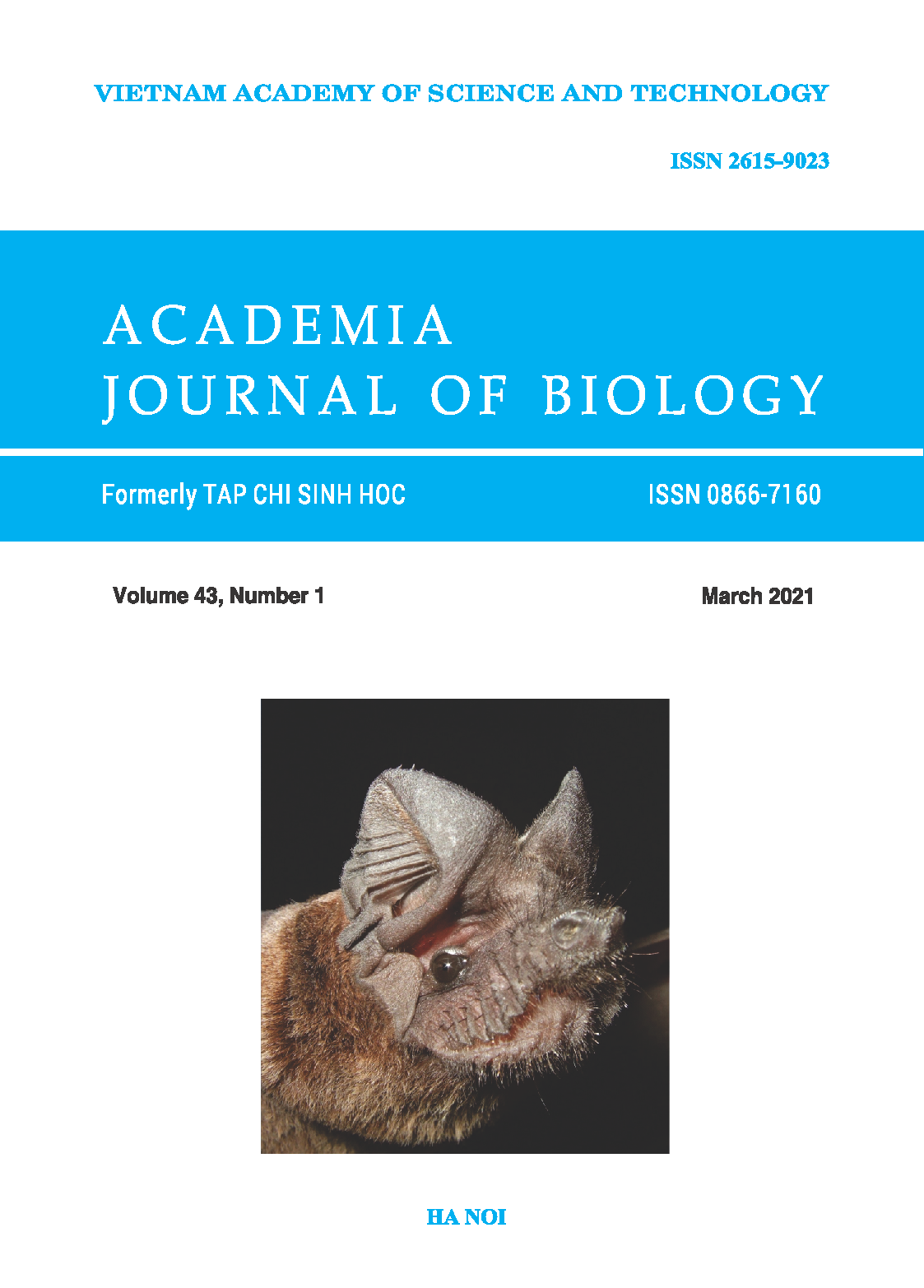Transcription expression of gene encoding cathelicidin CATHL4 in Vietnam indigenous yellow cattle
Author affiliations
DOI:
https://doi.org/10.15625/2615-9023/15457Keywords:
Vietnamese Yellow cattle, cathelicidins, CATHL4 gene, transcription level, qRT-PCR.Abstract
Cathelicidins, a family of host-defence peptides, are present in a diverse range of species, including fish, amphibians, birds, reptiles, and mammals. The evidence for the role of these cationic antimicrobial peptides in innate host defenses is convincing from the data of animal model and transgenic animal experiments as well as wildlife or domestic animals, indicating that the peptides protect against inflammatory and immune system after induction by bacterial infection. In this study, we present the assessment of transcription expression of CATHL4 gene which encodes indolicidin, a cathelicidin from indigenous yellow cattle of Vietnam. The research focused on RNA samples extracted from lung tissues and lymph node collected from diseased cattle which died of infectious respiratory symptoms and the healthy cattle which were slaughtered for food purposes. By quantitative real-time PCR, the relative expression of transcripts was determined and analyzed using the expression of YWHAZ gene as reference. The results showed that this gene was abundantly expressed at a higher level in tissues of the diseased cattle than in those of the healthy ones. In both infection and healthy states, the expression of CATHL4 in lymph nodes were higher than in lung tissues. This indicated that CATHL4 (indolicidin) may participate in functions against infectious pathogens.
Downloads
References
Baumann A., Kiener M. S., Haigh B., Perreten V. Summerfield A., 2017. Differential ability of Bovine antimicrobial cathelicidins to Mediate nucleic acid sensing by epithelial cells. Front. Immunol. 8(59). https://doi.org/10.3389/fimmu.2017.00059
Brahma B., Patra M. C., Karri S., Chopra M., Mishra P., Chandra De B., Kumar S., Mahanty S., Thakur K., Poluri K. M., Datta T. K., De S., 2015. Diversity, Antimicrobial Action and Structure A ctivity Relationship of Buffalo Cathelicidins. Plos One. https://doi.org/ 10.1371/journal.pone.0144741
Broekman D. C., Frei D. M., Gylfason G. A., Steinarsson A., Jörnvall H., Agerberth B., Gudmundsson G. H., Maier V. H., 2011. Cod cathelicidin: Isolation of the mature peptide, cleavage site characterization and developmental expression. Developmental and Comparative Immunology, 35: 296–303.
Gillenwaters E. N., Seabury C. M., Elliott J. S., Womack J. E., 2009. Sequence analysis and polymorphism discovery in 4 members of the bovine cathelicidin gene family. J Hered, https://doi.org/ 101093/jhered/esn112
Goossens K., Poucke M. V., Soom A. V., Vandesompele J., Zeveren A. V. and Peelman L. J,, 2005. Selection of reference genes for quantitative real-time PCR in bovine preimplantation embryos. BMC developmental biology 5, 27, https://doi.org/10.1186/1471-213X-5-27
Livak K. J. 1997 (updated 2001). Relative quantification of gene expression: ABI Prism 7700 Sequence Detection System, Applied Biosystems User Bulletin #2.
Livak K. J., Schmittgen T. D., 2001. Analysis of relative gene expression data using real-time quantitative PCR and the 2−ΔΔCt method. Methods, 25: 402–408.
Maier V.H., Dorn, K.V., Gudmundsdottir, B.K., Gudmundsson, G.H., 2008. Characterisation of cathelicidin gene family members in divergent fish species. Mol.Immunol. 45, 3723–3730
Shinnar A. E., Butler K. L., and Park H. J., 2003, Cathelicidin family of antimicrobial peptides: proteolytic processing and protease resistance. Bioorganic Chemistry 31, 425–436.
Zhang L., Jie H., Xiao Y., Zhou C., Lyu W. and Bai W., 2019. Genomic Identification and Expression Analysis of the Cathelicidin Gene Family of the Forest Musk Deer. Animals, 9, 481; https://doi.org/10.3390/ani9080481
Mookherjee N., Brown K. L., Bowdish D. M., Doria S., Falsafi R., Hokamp K., Roche F. M., Mu R., Doho G. H., Pistolic J., Powers J. P., Bryan J., Brinkman F. S., Hancock R. E., 2006. Modulation of the TLR-mediated inflammatory response by the endogenous human host defense peptide LL-37. J Immunol, 176: 2455–2464.
Tomasinsig L., Zanetti M., 2005. The cathelicidins - structure function and evolution. Curr Protein Pept Sci.; 6: 23–34. PMID: 15638766.
Whelehan C. J, Barry R. A., Meade K. G, Eckersall P. D., Chapwanya A., Narciandi F., Lloyd A. T. and O’Farrelly C., 2014. Characterisation and expression profile of the bovine cathelicidin gene repertoire in mammary tissue. BMC Genomics, 15: 128
Wuerth K., Hancock R. E., 2011. New insights into cathelicidin modulation of adaptive immunity. Eur J Immunol, 41: 2817–2819.
Downloads
Published
How to Cite
Issue
Section
License
Copyright (c) 2021 Academia Journal of Biology

This work is licensed under a Creative Commons Attribution-ShareAlike 4.0 International License.
Academia Journal of Biology (AJB) is an open-access and peer-reviewed journal. The articles published in the AJB are licensed under a Creative Commons Attribution-NonCommercial-NoDerivatives 4.0 International License (CC BY-NC-ND 4.0), which permits for immediate free access to the articles to read, download, copy, non-commercial use, distribution and reproduction in any medium, provided the work is properly cited (with a link to the formal publication through the relevant DOI), and without subscription charges or registration barriers. The full details of the CC BY-NC-ND 4.0 License are available at https://creativecommons.org/licenses/by-nc-nd/4.0/.












